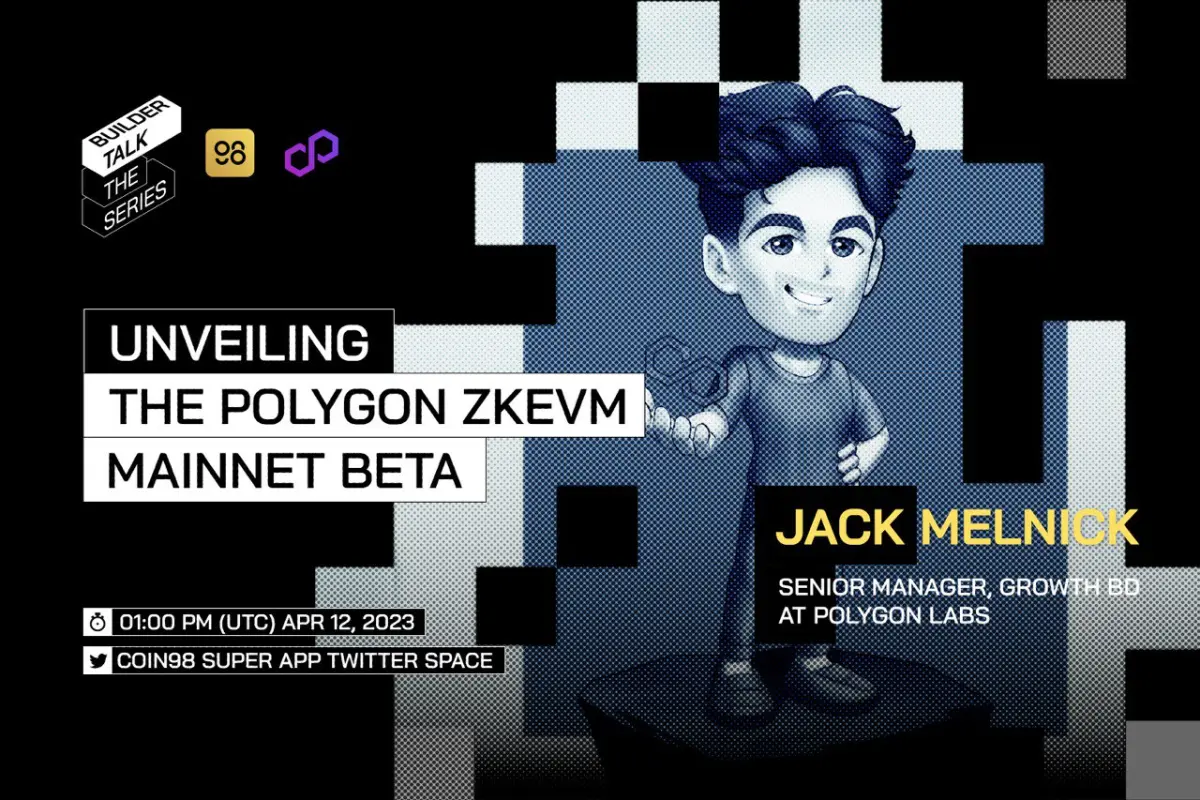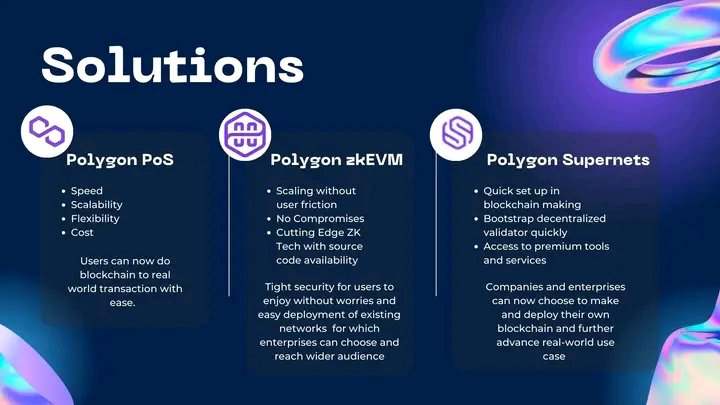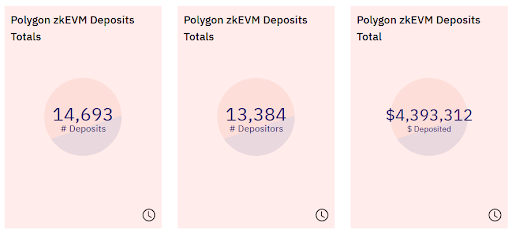BuilderTalk #5: A deep dive into Polygon zkEVM mainnet beta

Polygon is a sidechain that aims to solve multiple problems of Ethereum such as scalability, transaction speed, and gas fees. Founded in 2017, Polygon has become a top project with the largest market capitalization.
On March 27, Polygon released the beta version of Polygon zkEVM to the public. It means the community can experience the mainnet, where both users and developers can freely use and build products on this layer 2. However, there may occur delays or errors during the beta period.
— Coin98 Super App (Formerly Coin98 Wallet) (@coin98_wallet) April 12, 2023
While the Polygon Proof-of-Stake is a sidechain, Polygon zkEVM is a zk rollup layer 2 on Ethereum. It utilizes the zkEVM technology developed by Polygon Labs, a unit that works on scaling solutions for Ethereum. The zkEVM war has been getting more intense recently with the presence of various networks like Scroll, StarkNet, and zkSync.
Therefore, the discussion mainly revolved around zkEVM and Polygon’s plan for this technology. Besides key achievements, Jack shared some alpha leaks and their uniqueness over other networks like Immutable and Optimism.
A DeFi native
After leaving university, Jack used to work at several big hedge funds and learned about investment and how these companies work with the data for trading. In 2019, DeFi started to gain in popularity and caught Jack’s attention. As a person with a financial background, Jack found that DeFi could open more opportunities for him than the traditional market.
From there, he became a researcher anonymously for a year and a half before working as a full-time researcher at the end of 2021. Though he loved the team, he wanted to spend more time with the builders, explore what the biggest pain points were, and try to solve them in a hands-on way. And Polygon was a perfect place to do that.

Commenting on the term “builder,” Jack thought anyone coming in and helping push the space could be a builder. There were many different ways that people could contribute to the industry. When first hearing “builder,” people usually associate it with engineers who build the blockchain and work on top DApps.
“To the same degree, there are a lot of supporters behind the scenes of that project. They are people coming in and taking these seemingly crazy technological ideas and new experiments in decentralized blockchains. We need the ability to transform these crazy ideas into actual sustainable businesses.”
For Jack, it was ideal to have partners who were DeFi natives as well because they would have the same mindset and angle when approaching an issue. The BD team at Polygon was special about that.
Polygon zkEVM and Polygon PoS
To give a simple explanation, Jack pointed out that zkEVM was a combination of 2 different kinds of technology. The first is zk or zero-knowledge, a cryptographic method of verifying truths. The opposite of zk solutions is optimistic rollups, where all transactions are assumed valid without getting into details.
Meanwhile, zk uses a more complex cryptographic system. It helps users avoid all downsides of optimistic rollups, including the 7-day waiting period. Within 7 days, the verifier needs to submit proof that the transaction is invalid. Otherwise, the transaction will be officially approved. On the other hand, zk accepts the transaction as soon as the proof is approved by the verifier. According to Jack, this process only took about 30 minutes.

Simultaneously, the zk rollup is still standing on Ethereum, using ETH as a gas token and inheriting the security of Ethereum. Therefore, Polygon zkEVM is defined as layer 2, not a sidechain like the original MATIC network.
The second factor of zkEVM is EVM - Ethereum Virtual Machine. Fundamentally, zero-knowledge chains are not compatible with the EVM. To solve that problem, Polygon created Polygon zkEVM. The new technology allows developers on layer 1 Ethereum to transit their app onto layer 2. It is an important step because the developers may be reluctant to enter the space if the barriers are too high.
Fully DeFi-focused
Unlike other networks operating on the first principle of tech like Solana, Polygon took a more pragmatic approach. The goal is to scale the Ethereum network. They have enhanced that target through a sidechain, which is the current Polygon PoS. As time went by, rather than doubling down on something that looks like a legacy solution, the projects saw that zkEVM tech was emerging as a great alternative.
“zkEVM is a true layer 2 that has better compatibility with the existing EVM code base. It has better throughput and is the better option for DeFi native protocols,” said Jack.
They believed this would be a long-term project beginning with the launch of zkEVM. They hopefully make use of the zero-knowledge for their current PoS network and bridge that into the future. At the core, zkEVM’s launch was about the DeFi builders and solving all common issues that these applications had with the previous.
Those issues could be fee batch transactions, gas fees, and TPS. If a thousand transactions are being executed in an hour, the TPS on zkEVM will be lower than when there are ten thousand transactions in an hour. It is not because you are getting bottlenecked by the network throughput but because of the way that transaction batching happens on zkEVM.
The final important point is adapting the bridge. As zkEVM operates on an LX-LY bridge, it is fully operated by smart contracts and there is no multi-sig or custody whatsoever. Their goal is to lower the number of trust assumptions as much as possible.

Polygon is working with some top-tier projects as well as newer projects who are going to launch tokens and get the community involved to help build out a robust DeFi ecosystem. The network is ready to welcome everyone regardless of DeFi builders, retail users, or an institution.
“You want to facilitate liquidity, leverage lending, and borrowing. Whatever on-chain is going to be available in zkEVM and done in a way where it's hopefully tied together. And a lot of applications as well as chains have synergies to improve that UX barrier,” Jack shared with Coin98.
Regarding integrating the PoS chain into the zkEVM chain, Jack pointed out that many entity infrastructures already live on the PoS. Therefore, he thought there were no organic demands for moving to the zkEVM at the present. Jack insisted it could happen some days but in the short term, the community might expect zkEVM to be almost entirely DeFi-focused.
“If you look at some blue-chip DeFi governance forums, I have been submitting governor proposals through the DAO process for a lot of these kinds of blue-chip moves to zkEVM,” Jack hinted when asked about alpha leaks.
Commenting on other zkEVM blockchains, he stated zkEVM was hard to build so he respected all of their competitors. What Polygon was doing best was attempting to create a good solution for users. The first is the bridge, which is fast, easy to use, and has low trust assumptions. Any token that exists on the L1 can be bridged and mapped to the L2.
Polygon regarded their zkEVM to be fully EVM equivalent. There are sometimes issues with copying and pasting EVM-based codes onto an EVM chain. When the developers transfer their code base over, it would take less than a day to get it live on zkEVM. According to Jack, some of the other L2s take much longer to move those code bases.
Polygon zkEVM's achievement
Jack said that Polygon zkEVM was at a different stage of maturity than other competitors, who launch a token or haven't even launched a token yet, and can heavily incentivize users through that. Polygon is a mature company that develops zkEVM with few tokens to incentivize around in the same way. So it's much more about building something people want to use over the long term.
“So that's why I am just turning around building a tactical DeFi ecosystem,” Jack said.
There have been more than 4 million USD going through the bridge into zkEVM, and 14,000 users have now come over the bridge. Polygon zkEVM is not running at 100 TPS when there aren’t any transactions going through. So those numbers will be scaling up over time consistently.

The number of applications is consistently growing on the database. They are also working with the DeFi Teams, who are helping to track a lot of DeFi TVL, users, and protocols live on zk.
“It starts with the basic functionality around: swap protocol and bridge platform to help people move funds from L1, other L2, and CEX to zkEVM. From there, you can build a lending platform, different liquidity, and trading platform. Once the core functionality is down, people will build on top of the primitive. Then, they will move to the new primitive using the core function”, Jack added.
Polygon zkEVM is currently on stage 1 for the next one or two months. They want to make sure all core primitives are down. And once that is done, there will be more and more defi protocols popping up as people already have all the facilities they need.
Q&A Section
Future plan for Polygon zkEVM
What is the plan for the development of zkEVM?
The biggest thing is finalizing the base layer of DeFi infrastructure lending borrowing, Compound, Aave, SushiSwap, UniSwap, and bridge infrastructure like Hop, Synapse, etc. Once all that is down, we are at a point of EVM equivalent.
Beyond that, on the tech side, we are finalizing some differences from the current Ethereum Mainnet. The last thing is finding cool ways to use the tech natively across the Polygon platform. Polygon is different; zkEVM L2 is not our only product. We begin integrating zk tech into the POS sidechain to make it faster, more reliable, and better secure.
It’s about using zkEVM tech to build something like a supernet. Hybrid or off-chain DEX want to run on my L2; you can use zkEVM underlying tech to build on top of us. It’s about taking a young tech that people think needs 3 to 5 years out, and we can turn it around in 18 months.
What is the difference between Polygon zkEVm and Immutable zkEVM?
The difference is nothing. Immutable is excellently capturing market share on the NFT gaming frontier. For them, it was about finding a way to take that mindshare and pair with some of the best in class tech. So they knew they wanted to build in zkevm. We have a great relationship with the gaming studio already. They are using a lot of really cool gasless transactions and wallet infrastructure, which they have already built out for gaming companies. And Polygon is the backend filling all of that.
Right now, we currently do not run insensitive programs. The way blockchain development succeeds isn't throwing money away at projects. Sometimes, it is needed to support projects that need infrastructure or developers that need support. They build for the grant reason, not building for what they believe in.
Secondly, you would spend a lot of time deciding who got the money instead of working with builders to help them connect with the right people in the ecosystem, forming partnerships. So if I have 8 hours talking to projects, make them understand what they need to be successful, connect with market makers, connect with VC, connect with liquidity providers, and other protocols to scale out use cases. In the long term, all that is much more valuable than granting money.
Polygon zkEVM building process
Why Polygon zkEVM instead of Optimistic Rollups?
We didn't choose. We are evaluating Optimistic Rollups. For DeFi infrastructure, do we need to invest time in an optimistic rollup?
First of all, it's a very crowded space. Arbitrum has a good market fit; Optimism has done an excellent job scaling with Base. My idea, Optimistic, is crowded already. On top of that, many intelligent people tell me the tech from the zkevm side is simply better, more secure, has fewer trust assumptions, gets to a place complete evm equivalent, scale to higher throughput, and lower latency rollups.
It is a really obvious answer. Why would we compete in a super crowded space with tech in the medium term-time? Why do we do that over trying to build something that will lead to a new area?
What is different before and after you build zkEVM? Any challenges?
Vitalik thought it would take 3 or 5 years to accomplish this. Polygon products come to market much quicker than that, about 12 to 18 months. Along the way, a ton of different things come up, from solving EVM equivalent through compilation to figuring out how you probably scale the blockchain and communication, even cross-chain.
Polygon zkEVM but several other zkEVM in development took a different way to solve it. So in the short term, it is hard to say which of the solutions is best. Long-term will answer, and we are very flexible to adapt and ensure what we do is best.
The biggest thing is finalizing the POS native zkEVM bridge, figuring out ways to allow cross-chain communication from POS to zkEVM, searching to gain steam for Supernet, and providing the environment with less liquidity fragmentation.
That is one of the biggest problems. How do you avoid fragments of the universe? Polygon has multiple networks and tons of different Layer 2 competing for mind market share. We don't need to flush with incentives. We have to be much more consistent across the board on the BD side to help builders access non-grant value. How can I make anyone working with Polygon feel supported?
Focusing Polygon is a platform is a blockchain that users come to for something unique. Users need to go to Polygon for something native.
Alpha leak for Polygon ecosystem
A protocol named Dovish is alive on Polygon zkEVM, doing some cool stuff; they will have a token drop at some point. So keep an eye up for that.
Read more: BuilderTalk #4: Stride - A journey in Cosmos and beyond.
